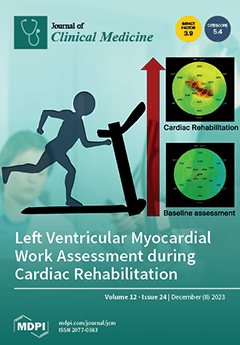The 3/7 resistance training (RT) method involves performing sets with increasing numbers of repetitions, and shorter rest periods than the 3x9 method. Therefore, it could induce more metabolic stress in people with heart failure with reduced ejection fraction (HFrEF) or coronary artery disease
[...] Read more.
The 3/7 resistance training (RT) method involves performing sets with increasing numbers of repetitions, and shorter rest periods than the 3x9 method. Therefore, it could induce more metabolic stress in people with heart failure with reduced ejection fraction (HFrEF) or coronary artery disease (CAD). This randomized cross-over study tested this hypothesis. Eleven individuals with HFrEF and thirteen with CAD performed high-intensity interval training (HIIT) for 30 min, followed by 3x9 or 3/7 RT according to group allocation. pH, HCO
3−, lactate, and growth hormone were measured at baseline, after HIIT, and after RT. pH and HCO
3− decreased, and lactate increased after both RT methods. In the CAD group, lactate increased more (6.99 ± 2.37 vs. 9.20 ± 3.57 mmol/L,
p = 0.025), pH tended to decrease more (7.29 ± 0.06 vs. 7.33 ± 0.04,
p = 0.060), and HCO
3− decreased more (18.6 ± 3.1 vs. 21.1 ± 2.5 mmol/L,
p = 0.004) after 3/7 than 3x9 RT. In the HFrEF group, lactate, pH, and HCO
3− concentrations did not differ between RT methods (all
p > 0.248). RT did not increase growth hormone in either patient group. In conclusion, the 3/7 RT method induced more metabolic stress than the 3x9 method in people with CAD but not HFrEF.
Full article






